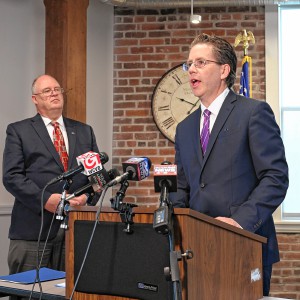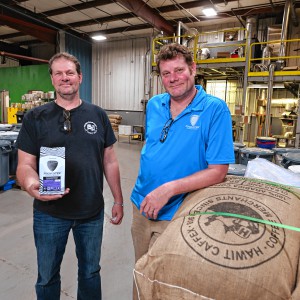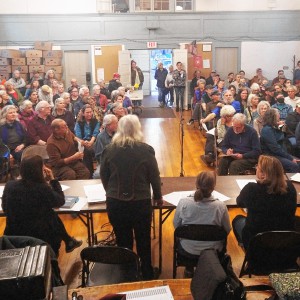Residents air concerns on clean energy, particularly solar siting, at Sunderland forum
| Published: 04-01-2024 3:34 PM |
SUNDERLAND — Residents and clean energy advocates recently got the chance to discuss all things energy with the top House member of the Joint Committee on Telecommunications, Utilities and Energy, with the siting of solar arrays holding particular interest for the community.
In a wide-ranging discussion at the Sunderland Public Library on Friday, state Rep. Jeffrey Roy, D-Franklin, highlighted Massachusetts’ investments in wind energy off the coast of Martha’s Vineyard, shared some of the Legislature’s energy priorities and fielded questions from Franklin County residents. The discussion was organized by Rep. Natalie Blais, D-Deerfield.
“If we put our minds to it, we can have economic prosperity at the same time we’re producing the clean energy that is necessary for us to achieve our goals of net-zero by 2050,” Roy said of state investments in clean energy. “The president set a national goal of 11 gigawatts of wind [energy] by 2030 and Massachusetts is already poised to provide six of those gigawatts. … We’re going to continue to push for these energy improvements.”
The visit coincided with the Executive Office of Energy and Environmental Affairs’ Commission on Energy Infrastructure Siting and Permitting report, which recommended the state define energy infrastructure in its laws, consolidate the permitting processes at the state and local levels for clean energy facilities, and establish community engagement requirements for developers.
Siting of clean energy projects, specifically solar projects, was one of the main points residents brought up with Roy, as several communities around Franklin County are seeing large developers proposing solar arrays. Around the region, Northfield has three approved arrays on Pine Meadow Road, with another one preparing to apply; Wendell is seeing a 105-acre battery storage facility; and Conway may see a solar array proposal in the coming months, too.
“Towns are going up against big companies and they don’t trust what the company reps. are saying, and the towns are scrambling to figure out what we should say about safety,” said Deerfield resident Sherry Morgan. “My question is, do you know if the state ever got anybody together to develop those safety and performance recommendations for storage facilities?”
Shelburne Falls resident Janet Sinclair said solar projects on farmland, such as those on Pine Meadow Road in Northfield, take “prime farmland” out of use and the state should not be incentivizing dual-use projects, but should instead encourage developments on rooftops, parking lots and other similar infrastructure. Developers have previously said that the Northfield projects are being designed as agrivoltaic arrays, meaning that farmers can still use the land for growing crops or grazing for their herds.
“The reason you’re seeing [lawsuits and appeals] isn’t because the towns are behaving badly, it’s because our subsidies for these projects encourage bad projects,” Sinclair said. “We should not be funding solar for anything, except for if it’s on rooftops.”
Article continues after...
Yesterday's Most Read Articles
 1989 homicide victim found in Warwick ID’d through genetic testing, but some mysteries remain
1989 homicide victim found in Warwick ID’d through genetic testing, but some mysteries remain
 Fogbuster Coffee Works, formerly Pierce Brothers, celebrating 30 years in business
Fogbuster Coffee Works, formerly Pierce Brothers, celebrating 30 years in business
 Greenfield homicide victim to be memorialized in Pittsfield
Greenfield homicide victim to be memorialized in Pittsfield
 Real Estate Transactions: May 3, 2024
Real Estate Transactions: May 3, 2024
 Battery storage bylaw passes in Wendell
Battery storage bylaw passes in Wendell
 As I See It: Between Israel and Palestine: Which side should we be on, and why?
As I See It: Between Israel and Palestine: Which side should we be on, and why?
Roy explained the proposed siting legislation, which would consolidate permitting for solar projects, is to “try and move things at a quicker pace” because right now, all 351 municipalities in the state have their own rules.
“The siting and permitting is not about taking away local control, absolutely not. The idea is that we have set goals to get to net-zero by 2050. The average time for a project from concept to shovel in the ground is about five years,” Roy said. “If we did that for every piece of infrastructure that’s necessary for us to achieve those goals, you might as well kiss those goals goodbye.”
Instead, Roy said the state’s goal is to bring the community voices “up front,” which would happen through the community engagement process, as once construction documents are created, “you can’t get people to change their minds.”
In its report, the Commission on Energy Infrastructure Siting and Permitting recommends municipalities “issue a single consolidated local permit, which contains all necessary local approvals,” within one year of receiving a completed application.
It also recommends legislative action to instruct the Department of Energy Resources to create a uniform set of health, safety and environmental standards; a standard application permit for local clean energy projects; and minimum pre-filing requirements for community engagement.
The full Commission on Energy Infrastructure Siting and Permitting report can be found on the state website at bit.ly/3VHm1XP.
Chris Larabee can be reached at clarabee@recorder.com.

 Wear Orange organizers prepare display to remember gun violence victims
Wear Orange organizers prepare display to remember gun violence victims Deerfield candidates, Whately incumbent discuss issues with voters at South County Senior Center
Deerfield candidates, Whately incumbent discuss issues with voters at South County Senior Center
